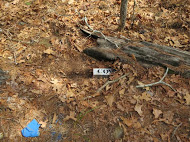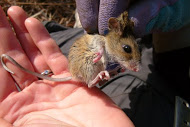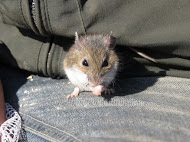Managing for Small Mammal Diversity
Introduction
Small mammals (rodents, moles and shrew-like species) provide important ecological services, without which many ecosystems could not function properly. They disperse mycorrhizal fungal spores necessary for the proper growth of several native plant species. They also disperse native seeds and increase germination rates by caching them. Additionally, burrow-digging species, such as moles, contribute to soil aeration. Small mammal species that feed on grass litter accelerate the cycling of nutrients. Small mammals can help regulate the abundance of other species by carrying diseases and parasites and by providing major food sources for many other species. Finally, some small mammals, like woodrats, build structures that promote the diversity and abundance of other species.
It is important to manage for native small mammal diversity because different species will provide different ecological services. The loss of small mammal diversity or changes in the abundance of a species could have cascading effects at various levels. The effects of land management practices on small mammal habitat should be considered.
Different habitat characteristics are important to different small mammal species. Some of these characteristics are described below. Examples of how management practices could be altered to favor small mammal diversity are provided. Finally, a case study is presented.
Small Mammal Habitat
Woody Debris
Woody debris, such as fallen dead trees and branches, are important for many small mammal species (Figure 1). Woody debris can provide corridors for movement and protect animals from predators and inclement weather. Debris can also offer nesting cover for pregnant females. Finally, some small mammal species will eat the insects feeding on rotting debris. For these reasons, management practices that retain woody debris will benefit some small mammal species.

Figure 1. The abundance of some species, such as the cotton mouse (Peromyscus gossypinus), is positively correlated with woody debris.
Snags
Snags (standing dead trees) provide similar benefits to small mammals. Snags can be used as protective and nesting cover and forage grounds. Snag retention is therefore recommended to encourage small mammal diversity.
Tree Density
Different small mammal species inhabit forest and savannas with different tree densities. For example, fulvous harvest mice (Reithrodontomys fulvescens, Figure 2) are usually found in savannas and grasslands, while southern flying squirrels (Glaucomys volans) inhabit forested areas. When harvesting timber, consider retaining some dense forest patches to maintain forest obligate species. Also consider thinning some dense stands that have been overgrown due to fire suppression.

Figure 2. Fulvous harvest mice thrive in savannas and grasslands.
Ground Cover Types
Different small mammal species are associated with different cover types. Some prefer a ground layer covered in litter, others need a ground layer predominantly covered with grasses, and yet others inhabit rocky outcrops. To fulfill basic needs, a single species often uses more than one cover type throughout a day, season or year. Therefore, monocultures should be avoided and patches should be managed for different cover types.
Vertical Structure
Small mammals can also respond to vertical vegetation structure. Some species require habitat with a strong shrub component, while others would avoid such habitat. Therefore, patches with different vertical structures and different heights of vegetation are most beneficial for small mammal diversity.
Case Study: Determining the Effects of Savanna Restoration on Small Mammals in Southeast Oklahoma
Resulting from decades of fire suppression, many open forests with a grassland understory became dense forests. In oak-pine forests of southeast Oklahoma, tree thinning followed by frequent prescribed fires is recommended to restore savannas.
A recent study determined the effects of tree thinning followed by frequent prescribed fires on small mammal communities in southeast Oklahoma. Different small mammal species were found in restored patches (patches thinned and burned on average every 2.5 years) when compared to unrestored patches (burned on average every three years to six years and not thinned). For example, researchers documented higher abundance of white-footed mice (Peromyscus leucopus, Figure 3) in restored patches. White-footed mice likely responded to variation in woody debris, differences in tree densities and ground layer complexity. Recommendations from this study included retaining woody debris and snags and maintaining restored and unrestored patches to ensure small mammal diversity.

Figure 3. In southeast Oklahoma, the white-footed mouse was more abundant during spring in plots that were thinned and burned.
Conclusion
Managing for small mammal diversity requires managing for specific habitat requirements. Retaining woody debris, snags and managing for different ground cover types—tree densities and vertical structures—are some ways to increase small mammal diversity. Managing for small mammal diversity can ensure different ecological functions required for the proper functioning of ecosystems are met.
Selected References and Supplemental Reading
Converse, S.J., G.C. White, K.L. Farris, and S. Zack. 2006. Small mammals and forest fuel reduction: national-scale responses to fire and fire surrogates. Ecological Applications 16(5):1717–1729.
Fuller, A.K., D.J. Harrison, and H.J. Lachowski. 2004. Stand scale effects of partial harvesting and clearcutting on small mammals and forest structure. Forest Ecology and Management 191:373–386.
Homyack, J.A., D.J. Harrison, and W.B. Krohn. 2005. Long-term effects of precommercial thinning on small mammals in northern Maine. Forest Ecology and Management 205:43–57.
Jacques, M.E. 2014. Low-basal area treatment and prescribed fire to restore oak-pine savannas alter small mammal communities. Master’s thesis. Oklahoma State University, Stillwater, OK. 95 pp.
Masters, R.E., R.L. Lochmiller, S.T. McMurry, and G.A. Bukenhofer. 1998. Small mammal response to pine-grassland restoration for Red-Cockaded Woodpeckers. Wildlife Society Bulletin 26(1):148–158.
Pearce, J., and L. Venier. 2005. Small mammals as bioindicators of sustainable boreal forest management. Forest Ecology and Management 208:153–175.
Perry, R.W., and R.E. Thill. 2005. Small-mammal responses to pine regeneration treatments in the Ouachita Mountains of Arkansas and Oklahoma, USA. Forest Ecology and Management 219:81–94.
Photographs
Photographs were taken for a small mammal study approved by the Institutional Animal Care and Use Committee (ACUP AG-12-16). Photo credits: V. Biral, N. Ferreira, M.E. Jacques, R.M. Rahal, and F. Secanho.
Marie-Eve Jacques, M.S.
Restoration Ecologist
Dr. Karen McBee
Professor & Curator of Vertebrates
Department of Zoology
Dwayne Elmore
Wildlife Ecology and Management Specialist
